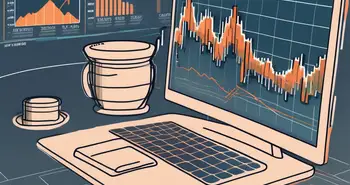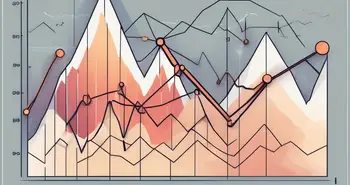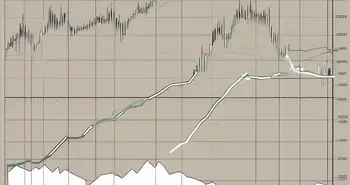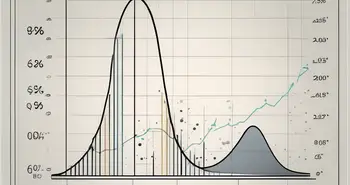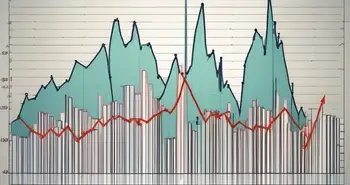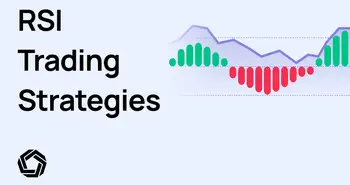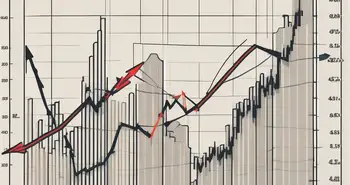VWAP Indicator: How to Use It, Strategies and Pro Tips
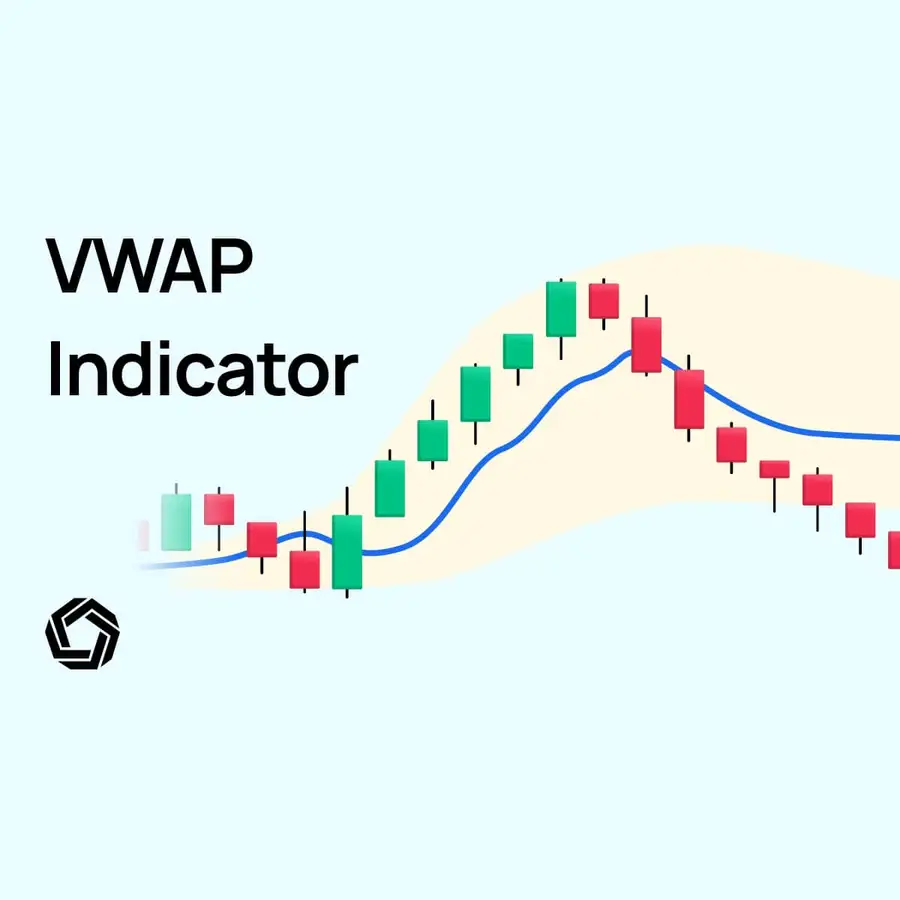
The Volume Weighted Average Price (VWAP) indicator is a important tool in technical analysis, offering a unique perspective by incorporating both price and trading volume. This indicator is widely used by traders to understand the average price of a security throughout a trading session, providing a clearer picture of market trends and conditions.
As Ananth Madhavan, Managing Director of Research of ITG in New York, stated in his study:
“While VWAP strategies are relatively straightforward in concept, their implementation can be difficult.”
This guide will provide an in-depth understanding of the VWAP indicator, along with actionable strategies that can be implemented right away. We'll begin with the fundamentals, move on to various trading strategies, and conclude with a discussion on potential pitfalls.
- What is the VWAP Indicator?: Comparison to Moving Averages Indicator
- VWAP Trading Strategy Ideas: Buy and Sell Strategies
- The Potential Pitfalls of Using VWAP in Trading
What is the VWAP Indicator?
VWAP (Volume Weighted Average Price) is an average price that factors in both time and trading volume. Unlike a simple average, VWAP gives a clearer view of market sentiment and price direction by emphasizing periods with higher trading activity. This makes VWAP a better tool for understanding market sentiment and price trends. The VWAP formula is simple:
VWAP = ∑(Price * Volume) / Total Volume Traded
- Price represents the price of the security at each trade.
- Volume represents the number of shares or contracts traded at each price.
- Total Volume Traded is the sum of all trading volumes within the specified time frame.
- VWAP calculates the weighted average of prices based on the volume traded at each price level, giving more importance to trades with higher volumes.
VWAP is represented as a single line on trading charts, typically displayed as a continuous line running through the chart's price data. In the chart below, it is represented as a blue line for easy visibility. You can use this line to assess whether current prices are above or below the average price weighted by trading volume.
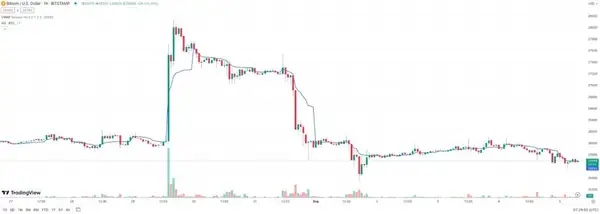
The optimal settings for the VWAP (Volume Weighted Average Price) indicator can be contingent on factors like your trading approach, the asset you are trading, and your chosen time frame. We recommend using the VWAP indicator for intraday trading or swing trading.
Intraday Trading
This is the lowest timeframe you can go in trading. For short-term scalping, you may choose a “Session” timeframe ranging from 1 to 5 minutes. A “Session” timeframe of 5 to 15 minutes may be more appropriate for broader intraday trading strategies.
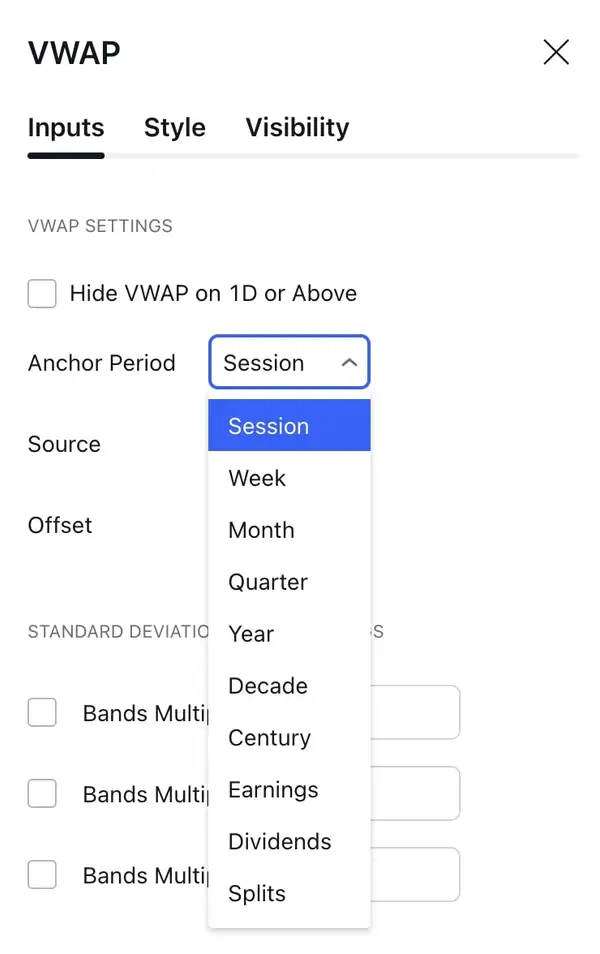
Swing Trading
For multi-day VWAP, you would need to adjust the VWAP period to span several “Weeks” or “Months” within the “Week” or “Month” timeframe settings.
To supplement the VWAP line, you have the option to add standard deviation bands within your selected session-based timeframe for assessing volatility.
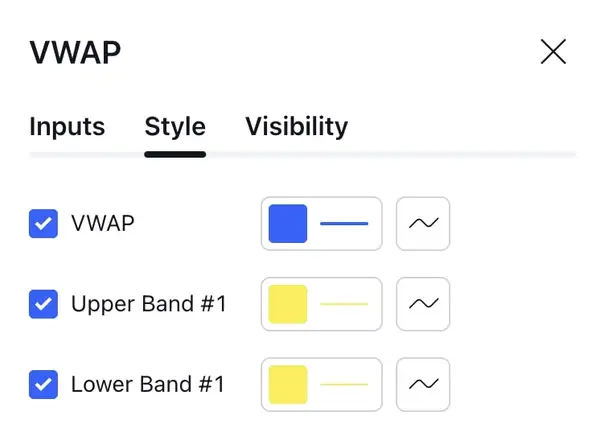
As the accompanying chart demonstrates, standard deviation bands—depicted in yellow—are incorporated. These bands serve multiple functions: they offer insights into price volatility, help identify support and resistance levels, confirm prevailing trends, signal conditions of being overbought or oversold, provide cues for exit and take-profit points, and aid in risk management. You have the flexibility to tailor these bands to adapt to various market conditions and strategies, enhancing their utility in your technical analysis.
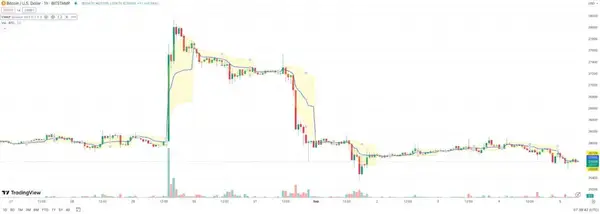
Importance of VWAP in Trading
VWAP, or Volume Weighted Average Price, is crucial in your trading activities for several reasons. First, it serves as a benchmark for you, allowing you to evaluate if you are entering into positions at prices that are favourable (below VWAP) or selling at levels that are advantageous (above VWAP). VWAP also assists you in risk assessment by offering data on how much the current price deviates from the average price backed by trading volume. In fact, according to research of Jędrzej Białkowski, Serge Darolles, Gaëlle Le Fol, it is possible to reduce execution risk in VWAP (Volume Weighted Average Price) orders by modelling intraday volume.
Additionally, VWAP supports your decision-making by delivering valuable intel on market trends. In an intraday session chart with a 15-minute timeframe, you might observe price surges above the VWAP indicator, indicating a likely bullish trend. After this, significant volume may funnel in, further elevating the price above the VWAP line in a bullish movement. Finally, the price could re-test the VWAP line and press for higher highs during the session.
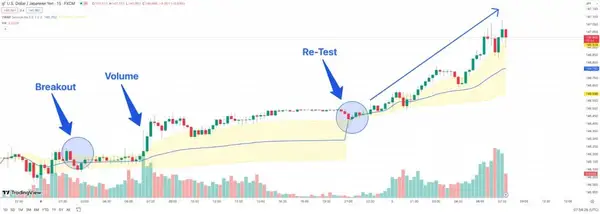
Comparing VWAP to Other Indicators
Compared to other indicators like simple moving averages, VWAP has distinct features. It includes volume data in its computations, giving you a more rounded understanding of market behaviour. This separates it from moving averages that only focus on price data. In a chart, you might notice that VWAP, indicated within blue boxes, is particularly responsive to price swings accompanied by large volume. The magnitude of candle sizes in the volume chart below might directly influence how strongly the VWAP reacts, setting it apart from a lagging moving average, typically represented by a purple line.
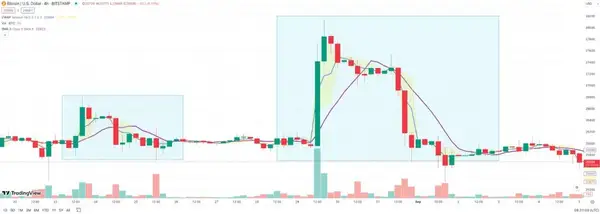
You might also find it beneficial to use VWAP in tandem with other indicators. This dual application offers several advantages: First, it can corroborate potential trading opportunities, boosting your confidence in your trading decisions. Second, it helps you accurately pinpoint entry and exit points, especially valuable in volatile market conditions. Lastly, it supports you in risk management by helping set stop-loss and take-profit levels based on price proximity to VWAP.
In summary, the unique capacity of VWAP to integrate volume data into average price calculations renders it an indispensable tool in your trading strategy. You can count on VWAP to benchmark prices, evaluate risks, and make informed decisions for short-term or long-term trades. When employed alongside other indicators, VWAP can augment the precision and efficacy of your trading approach.
VWAP Indicator vs. Moving Averages
Both the VWAP indicator and moving averages are essential tools in technical analysis, used to identify trends and make informed trading decisions. However, they have unique characteristics and applications.
VWAP Indicator:
- Incorporates Volume: VWAP integrates both price and volume, providing a volume-weighted average price.
- Intraday Focus: Primarily used for intraday trading, resetting at the end of each trading day.
- Benchmark: Serves as a benchmark for assessing the average price of a security throughout the trading session.
Moving Averages:
- Price Focused: Moving averages (e.g., SMA, EMA) are calculated based on price data alone, without considering volume.
- Versatile Timeframes: Applicable to various timeframes, from minutes to months, making them useful for both short-term and long-term analysis.
- Trend Identification: Helps identify the overall direction of price trends over a specified period.
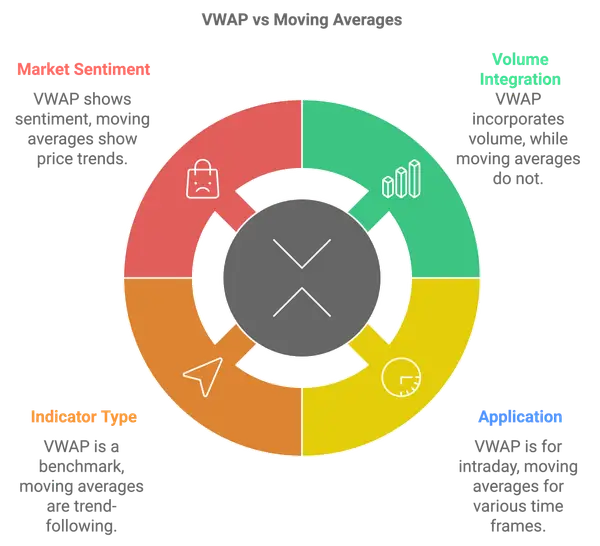
Strategical Tips for Using VWAP Indicator vs. Moving Averages
When to Use VWAP:
- Intraday Trading: Ideal for day traders who need to understand the average price of a security during a single trading session.
- Volume Analysis: Useful when volume plays a critical role in price movements, providing insights into whether a price move is supported by substantial trading activity.
- Entry and Exit Points: Helps determine optimal entry and exit points by comparing current prices to the VWAP line.
When to Use Moving Averages:
- Trend Following: Suitable for identifying and following long-term trends in the market, helping to avoid trading against the market's direction.
- Crossovers: Employ moving average crossovers (e.g., SMA crossing above EMA) to signal potential buy or sell opportunities.
- Support and Resistance: Acts as dynamic support or resistance levels in trending markets.
Combining VWAP and Moving Averages:
- Confirmation Tool: Use VWAP to confirm trends identified by moving averages, ensuring that price movements are supported by volume.
- Enhanced Entries and Exits: Utilize moving averages to spot potential trade opportunities, while VWAP refines entry and exit points based on volume-weighted price levels.
- Risk Management: Moving averages provide a broad trend direction, while VWAP offers a precise benchmark for price deviations, aiding in effective risk management.
VWAP Trading Strategy Ideas
As researcher and trading expert Takashi Kato puts it in his study:
“As an execution strategy that exploits trading volume, the volume weighted average price (VWAP) strategy is well known and widely used in practice.”
Obviously, imagining a specific strategy without seeing it in the charts is always tricky, so we always prepare some real-world examples. We will show you two simple strategies for buying and selling according to the VWAP indicator. These strategies are aimed at beginners, and you can apply them immediately in your trading approach.
VWAP Buying Strategy

This real-world example focuses on effectively utilizing the VWAP strategy with GameStop (GME) stock on a 5-minute chart. Although GME is chosen due to its high daily volatility, you can apply the strategy to any stock you're trading. The scenario concentrates on going long on daily breakouts above the VWAP line.
Step 1: Identifying the Breakout – 18.10 Breakout
Initially, your task is to identify a breakout. With GME being highly volatile, daily breakouts are not uncommon. At an 18.10 price level, you can observe a breakout above a critical resistance point on the 5-minute chart. The absence of a surge in volume during this breakout doesn't conclusively confirm bullish momentum. The VWAP line remains relatively stable, suggesting this may not be the ideal entry point. However, it's an initial indicator of potential bullish activity, hinting that a price surge may be forthcoming.
Step 2: The Re-Test of VWAP – Wait for Better Entry
Though the initial 18.10 breakout suggests a possible entry, you, like many seasoned traders, would recognize that a re-test of the VWAP often provides a more reliable setup.
Step 3: Recognizing the Re-Test – 18.30 Entry
Post-initial breakout, the price of GME retracts toward the VWAP level (re-test). This retraction is marked by reduced volume, suggesting the waning of selling pressure. As the price nears the VWAP, it doesn't decisively break below this level owing to insufficient selling volume. Instead, it establishes a lower high, indicating possible strength in the stock.
Step 4: The Surge Above VWAP – 18.30 to 19.40
When GME's price subsequently ascends above the VWAP line, this time backed by significant volume, it's a clear indicator that buying control is reasserting itself, and a sizable price movement is imminent. If you entered the trade at around 18.30 during the VWAP re-test, you would be well-positioned to capitalize on the ensuing price surge, which sees GME moving from 18.30 to 19.40 within a short time frame.
Step 5: Exiting the Trade – Price Retracement to VWAP
Upon GME hitting 19.40, you would closely scrutinize the stock's behaviour. Noting the significant move, you understand the prudence in taking profits. As the price reverts to the VWAP level, it offers you an opportune moment to exit the trade, thus securing your gains.
This example underscores the efficacy of the VWAP strategy when trading highly volatile stocks like GME. By patiently waiting for a re-test of the VWAP following a breakout, you heighten the odds of entering a trade that aligns with the prevailing trend. The VWAP serves as a dynamic support and resistance level, aiding you in decision-making and effective risk management. The adaptability of this strategy to diverse stocks and timeframes furnishes you with a versatile tool for capturing short-term price movements.
VWAP Selling Strategy
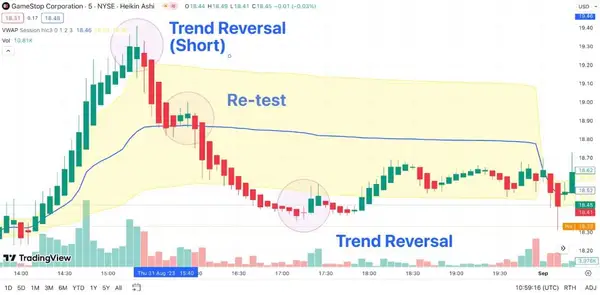
This strategy provides a comprehensive approach to trading bearish reversals by combining the use of Heikin Ashi candles and the VWAP (Volume Weighted Average Price) indicator. Aimed at traders looking to profit from price breakdowns, this strategy is illustrated on a 5-minute chart of GameStop (GME) stock, a volatile trading instrument.
Step 1: Identifying the Breakout – 19.30 Entry
In the first step, you notice GME breaking out above a key resistance level at 19.30. This breakout is accompanied by a significant uptick in volume, and the price candles push beyond the upper yellow VWAP band.
Step 2: Confirming with Heikin Ashi – Entry Point
Before entering the trade, you consult the Heikin Ashi candles. They turn red, signalling bearish momentum. When this happens with increased selling volume, it's a robust confirmation for initiating a short position.
Step 3: The Re-Test of VWAP – Wait and Adjust
After establishing a short position, you wait for the price to retrace to the VWAP level, a crucial area for trend continuation. During this period, you closely observe price action, ready to adjust your stop loss if you see signs of trend reversal.
Step 4: Recognizing the Re-Test – Steady at VWAP
You notice that the volume is relatively low during the retracement, suggesting sellers are losing momentum. Importantly, GME doesn't convincingly break above the VWAP level due to lacklustre buying volume. This indicates potential weakness and reaffirms that sellers are still in control. You decide to stick with your existing short position.
Step 5: Riding the Trend – Stop Loss Adjustment
While maintaining your short position, you closely monitor GME's performance. As the stock continues to decline, you adjust your stop loss to just above the VWAP level to manage risk effectively.
Step 6: Exiting the Trade – Price Retracement to VWAP
As you continue holding the short position, you look for signs of a potential trend reversal. Here, Heikin Ashi candles and the VWAP indicator are your guiding lights. Specifically, you watch for the Heikin Ashi candles to diminish in size and possibly change colour while also monitoring if the price is approaching the lower VWAP band, signalling a potential oversold condition.
Step 7: Exit Confirmation – Around 18.40
Finally, when GME reaches around 18.40, the Heikin Ashi candles show signs of indecision or reversal. At this point, you decide to exit the short trade, locking in your profits.
Blending Heikin Ashi candles and VWAP increases the likelihood of capturing well-timed, bearish trades. The attention to detail—waiting for the price to retest VWAP, confirming with Heikin Ashi, and continual stop-loss adjustment—ensures that the trader stays aligned with the prevailing trend while managing risk effectively. As a result, this strategy proves versatile and adaptable across various stocks and timeframes, making it a valuable approach for traders focused on bearish reversals.
Risk Management Using VWAP
The Volume Weighted Average Price (VWAP) is commonly implemented for identifying trade entry and exit points, but it also possesses utility for risk management. We usually recommend two main points to keep in mind when using the VWAP indicator for risk management:
Stop-Loss and Take-Profit Parameters: For trades positioned long, a stop-loss level below the VWAP is often implemented. Conversely, for short positions, a stop-loss above the VWAP is standard. As you saw in the previous strategy, you might also use the bands around the VWAP levels to set your stop loss and take profits.
Re-Entry Point Assessment: When an initial trade is stopped, the VWAP can serve as a reference for re-entry. Re-engagement with the position is typically considered upon the price nearing the VWAP, aligned with confirmation from other indicators. This is similar to the previous strategy, where we entered the position once the VWAP level was retested.
The Potential Pitfalls of Using VWAP in Trading
VWAP (Volume Weighted Average Price) is a powerful tool in a trader's arsenal, but like any trading indicator, it comes with its own set of limitations and potential pitfalls that traders need to be aware of. In this section, we'll explore these limitations and discuss strategies to mitigate their impact.
Late Signals
One of the primary pitfalls of using VWAP is the potential for late signals. VWAP calculations are based on historical data, which means they may not provide real-time signals. This is not such a big issue, as most of the indicators are based on historical data, but one must be aware of it. As a result, you might miss out on some early entry or exit opportunities, especially in fast-moving markets. Luckily, the VWAP is a rather responsive indicator, yet traders need to be cautious about relying solely on VWAP for immediate decision-making.
How to Mitigate Late Signals:
- Combine with Other Indicators: To address this issue, consider combining VWAP with other technical indicators that provide more timely signals. For example, you can use shorter-term moving averages or momentum oscillators to confirm VWAP signals.
- Intraday Monitoring: Continuously monitor your trade and market conditions. Be ready to adjust your strategy or exit a trade if you notice significant price movements that are not reflected in VWAP.
Market Noise
VWAP can be sensitive to market noise, especially in lower-volume stocks or during volatile trading sessions. Market noise refers to random price fluctuations that can distort the accuracy of VWAP calculations. In such cases, VWAP may not provide a clear picture of the true market sentiment. Also, refrain from using the VWAP filter right after it gets reset. For example, if your settings are set to a “Weekly” timeframe for the VWAP, then you should wait for the first hours of the week to allow the VWAP to arrive at an adequately calculated value.
How to Minimize the Impact of Market Noise:
- Use Higher Time Frames: When dealing with noisy markets, consider using higher time frames like the 1-hour or 4-hour charts. Higher time frames can help filter out some of the short-term market noise.
- Volume Filter: Implement a volume filter alongside VWAP. Only consider VWAP signals when trading volume exceeds a certain threshold. This can help reduce the impact of noise on your trading decisions. In the chart below, you can see a volume indicator and a volume filter below the chart. The volume indicator is showing even the smallest volume; the volume filter only shows more significant volume moves. You can get both indicators simply by searching in the indicators toolbox above the chart.

Not a Standalone Indicator
Perhaps the most critical pitfall to avoid is relying solely on VWAP as a standalone indicator. VWAP is a valuable tool, but it's most effective when used in conjunction with other trading strategies and indicators. Depending solely on VWAP can lead to missed opportunities and increased risk.
Why VWAP Should Be Used Alongside Other Indicators:
- Confirmation: Combining VWAP with other indicators like moving averages, RSI, or MACD can provide confirmation of signals. When multiple indicators align, it strengthens the validity of a trade setup.
- Diversification: Relying solely on one indicator can lead to a narrow view of the market. Using a diverse set of indicators allows you to consider various aspects of price action, volume, and momentum.
How to Avoid Pitfalls
To maximize the utility of VWAP while mitigating its inherent limitations, you may find the following guidelines useful:
Educate Yourself: Acquiring a comprehensive understanding of VWAP, its applications, and its limitations positions you well for effective utilization. Knowledge remains a pivotal asset in your trading toolkit. Check our article on “How to Grow A Small Trading Account“; you may find it helpful. It offers actionable tips and insights that can be applied (regardless of whether your financial goals are big or small) to maximize your earnings and minimize risks. That guide will also take you a step further and show you how to create a winning strategy and a great trading system.
Combine with Other Indicators: Utilizing VWAP in isolation can expose you to unnecessary risks and missed opportunities. Therefore, it's prudent to use VWAP alongside other technical indicators for a more robust signal confirmation process. Read our feature on “Technical Analysis Using Multiple Timeframes” to get more ideas on how to implement other indicators and charting techniques.
Adapt to Market Conditions: Understanding that VWAP's efficacy can fluctuate based on market volatility and liquidity conditions enables you to modify your strategies as needed. This adaptability could prove crucial in maintaining a consistent performance. As for further reading on this matter, you might want to understand how market cycles work in general. To gain a deeper understanding of these dynamics, check out our guide on “Market Cycles” which shows you how to stay ahead of the game.
Conclusion
At Morpher, we believe that every great trader starts with small, calculated steps. Whether you’re just getting started or refining your skills, it's important to test your strategies with smaller amounts before scaling up. Begin by deciding on your strategy—whether short or long timeframes—and build your experience as you go. VWAP (Volume Weighted Average Price) combined with complementary indicators tailored to your style can be your secret weapon for success.
Smart risk management is crucial to protect your capital. Use VWAP to confidently set stop-loss and take-profit points, ensuring your trades are backed by data. But remember, trading is a continuous learning process. As market conditions shift, adapt your strategies and be patient, waiting for clear, reliable signals. Sometimes, the best move is knowing when not to trade.
Don't hesitate to apply the buy and sell strategies we’ve shared, as they’re ready to implement today. Stay sharp with Morpher’s comprehensive guides and insights to stay ahead of market trends. With persistence and the right tools, you’ll unlock VWAP’s full potential and be on your way to making smarter, more profitable trades.
Start trading confidently with Morpher today – your journey to success begins now!

Disclaimer: All investments involve risk, and the past performance of a security, industry, sector, market, financial product, trading strategy, or individual’s trading does not guarantee future results or returns. Investors are fully responsible for any investment decisions they make. Such decisions should be based solely on an evaluation of their financial circumstances, investment objectives, risk tolerance, and liquidity needs. This post does not constitute investment advice.

Painless trading for everyone
Hundreds of markets all in one place - Apple, Bitcoin, Gold, Watches, NFTs, Sneakers and so much more.

Painless trading for everyone
Hundreds of markets all in one place - Apple, Bitcoin, Gold, Watches, NFTs, Sneakers and so much more.

